Review by Paul Williams, photos by Paul Williams, and courtesy California State Parks
The most striking thing about arriving at San Diego by air is that it looks like you’re going to land in the middle of downtown. Turns out, you are.
Unlike most metropolitan airports, this one’s very handy to the city. Once on the ground, you’re right next to the water; a short taxi ride to downtown hotels.
And if it’s a typical San Diego day, the weather will be wonderful. Officially classed as “semi-arid,” the average temperature throughout the year ranges from a low of 14 degrees in January to a high of almost 23 degrees in August. During the day, the high temperature ranges between about 19 and 25 degrees, depending on the month. For many Canadians, this could be the climate of your dreams.
The San Diego tourism website can help with destinations. There you’ll find a smorgasbord of things to do in the area, helpfully arranged by category. We used it to get the lay of the land and to find out what events were scheduled during our stay.
Our base? Coronado Island, a community of about 25,000 people located in San Diego Bay, accessible by a multilane lane bridge (no tolls) that spans the water, or by ferry. We stayed at the Hotel Del Coronado – an interesting, historic and luxurious assembly of buildings, restaurants and gardens – courtesy of Hyundai Canada (who used the venue for the launch of the 2013 Hyundai Santa Fe XL). We also had the use of a Hyundai Santa Fe Sport – the five-passenger version — to better explore the region.
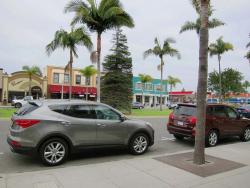 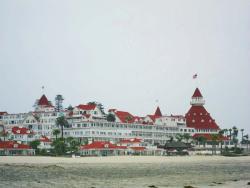 On Orange Avenue, Coronado & Hotel Del Coronado. Click image to enlarge |
Coronado Island is nice enough that you can while away much more time than you expect, what with the wonderfully maintained Coronado Central Beach, the numerous classic vehicles that many locals favour, the fine restaurants on Orange Avenue, the warm breezes and altogether civilized pace.
But we wanted to get a sense of San Diego’s surrounding topography, so headed back to the mainland, briefly took the I-5 north, then drove east on the I-8. Even though San Diego is a good-sized city at 1.3 million inhabitants, you’re out town in a matter of minutes on the Interstate.
Our Santa Fe Sport was the 2.0T version, which meant it was powered with a turbocharged, direct-injected four-cylinder engine making 264 horsepower and 269 pound-feet of torque (the “base” engine is a 2.4L “four,” making 190 hp). In “Limited” trim here in Canada, the price of our fully loaded Santa Fe would be $38,499. And just so you know, in the US the Santa Fe Sport is the 2.0T version, and base version is simply called the Santa Fe. Here in Canada, both are called the Santa Fe Sport.
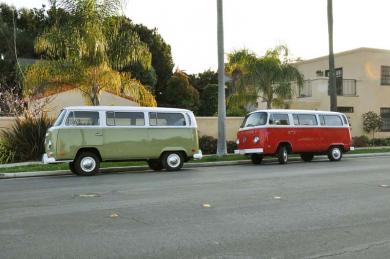 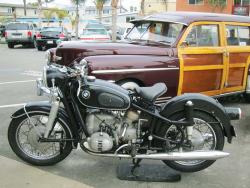 Classic Vehicles on Orange Avenue. Click image to enlarge |
Cruising on the highway, the 2.0T engine is all but silent, and under acceleration is likewise smooth and quiet. It’s amazing how far four-cylinder engine technology has come in the past decade, with power and responsiveness equalling or besting the V6 engines many are replacing. Fuel consumption is improved, too, with all Santa Fe models now including an ActiveECO system that modifies engine and transmission operation to increase fuel economy by up to seven percent, according to Hyundai.
Further down the road – and we promised ourselves we weren’t going to do this – we stopped at a ubiquitous feature of the American landscape, the outlet mall. We went (I swear to you) because a California Welcome Center was there, and we wanted maps and information.
But once at the Viejas Outlet Center, we had to marvel at the impressive vision behind it. This is something we just don’t do well in Canada: make outlet malls that actually look nice.
First of all, the entire facility is sensitively modeled on a First Nation village theme. Natural rock formations, bronze sculptures and water features blend harmoniously into the environment and the whole place has a pleasant feel to it. Oddly (I guess), it’s also the location of Southern California’s largest outdoor ice rink.
We went to the California Welcome Center as planned, succumbed briefly to the Nike store, and continued our drive.
As we drove the landscape changed, getting drier and more rugged by the kilometre. Strong winds blow almost continuously in this area, and road signs regularly warn drivers of dangerous gusts while wind farms become the dominant feature. Honestly, when it comes to wind farms, I’d prefer looking at a Canadian outlet mall.
Fortunately, the Santa Fe was not adversely affected by the strong crosswinds. You could feel them, alright, but minor corrections were sufficient to keep the vehicle tracking straight. Additionally, the Santa Fe’s Vehicle Stability Management system can deliver counter-steering to help keep it on the road and under control in adverse conditions like these. The Driver Selectable Steering Mode (standard equipment) can be used to provide more or less steering effort as desired, and this year the Santa Fe gets an Active Cornering Control to improve traction and turning performance when accelerating through a corner.
This is a vehicle that feels very substantial, even though it’s one of the lightest in its class (competitors would be the Ford Edge or Escape, Toyota RAV4, and Chevrolet Equinox, to name a few). In conjunction with the MacPherson strut front suspension and fully independent multi-link rear suspension, it adds up to a reassuringly stable vehicle on all road surfaces.
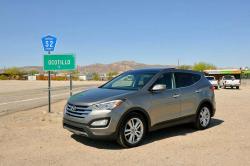 Ocotillo, California. Click image to enlarge |
We were headed to Ocotillo, where the road surfaces would become uneven and broken in places, and most of the traffic would be left behind. According to the friendly tourist person at the Welcome Center, we should take County Road S2 north, heading first into the desert, then into the mountains, reaching the town of Julian at an altitude of about 4,000 feet.
There we were advised to sample Julian’s signature claim to culinary fame: the apple pie.
County Road S2’s alternative name is “The Great Southern Overland Stage Route of 1849,” but we only saw a small sign for The Imperial Highway. None of these three names were on Santa Fe’s usually helpful navigation system.
Sure enough, “The Imperial Highway” was the “S2” and at the end of the exit ramp, “The Great Southern Overland Stage Route of 1849” is crammed into a sign roughly attached to a short post. We’d made it.
I’m not sure what we expected, but Ocotillo wasn’t it. If you want an old-style border town, Tecate (Tek-ah-tay) is recommended, although it’s actually in Mexico. Ocotillo – windblown, dry and dusty – consists of a few houses, a Sheriff’s office, some abandoned buildings and a bar complete with sleeping dog on the floor, a giant bearded guy of unpredictable disposition behind the counter, and a couple deep in conversation over their pitcher of beer. I know, it sounds interestingly authentic, but basically, this is the place where you head north.
The Great Southern Overland Stage Route (aka County Road S2, The Imperial Highway, San Felipe Road and Sweeney Pass) was apparently described by the San Diego Herald Tribune as California’s least travelled highway. It was at one time used to deliver mail and passengers from San Antonio, Texas and points east to the Pacific. Back in 1857, that journey from San Antonio took between one and two months, and the Apache, whose land the route traversed, were typically as inhospitable to visitors as was the parched landscape.
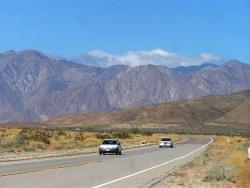 Anza-Borego Desert State Park. Click image to enlarge |
Interestingly, the route wasn’t paved until 1959–1961, according to the County of San Diego Department of Public Works (DPW). The paving came as a result of some local property owners who also petitioned for a name change from Imperial Highway to The Great Overland Stage Route of 1849.
The landscape now is much as it was then: boulders and sand, sagebrush, rocks and cactus. But a new wrinkle is the Border Control checkpoint. I guess it makes sense to locate a checkpoint on a road that hardly anyone uses (it would surprise the bad guys?). Then again, you’d think that “persons of interest” would know the checkpoint is on this road and would therefore avoid it.
“The Supervisors agreed,” says the DPW’s Tom Davis, “despite the fact that the Overland Mail Route was never known as “Great,” the route was not “Southern,” and it didn’t exist in 1849.”
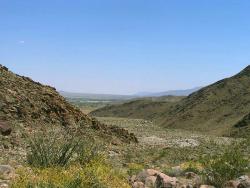 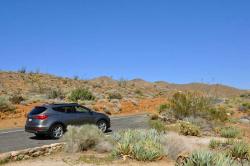 On Great Southern Anza-Borego Desert State Park & Overland Stage Route. Click image to enlarge |
Either way, our Canadian passports likely made a change for the officers stationed there, who made the most of our visit by engaging in friendly chat to pass some time. They liked the Santa Fe, too; seemingly more interested in its “Fluidic Sculpture” design (new for 2013) than the possibility of contraband hidden somewhere in its cargo area (I’m sure they know what they’re doing…).
The 2013 Santa Fe’s appealing exterior lines suggest a price tag that exceeds its MSRP, and the new look visually aligns it with other vehicles in the Hyundai lineup, including the Tuscon, Sonata, Elantra and Accent. The Veracruz, by the way, is now replaced by the equally fluidic Santa Fe XL.
Beyond the checkpoint, the road heads into the hills, the wind farms are finally left behind and if you like “remote,” you’ll like this place.
Hard to believe people hauled wagons through this brutal and inhospitable terrain, after which the mountains peeking up from the horizon would have promised even more travails to come. But among the boulders there were flashes of colour as spring flowers come into bloom between March and May.
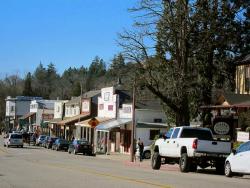 Main Street, Julian, California. Click image to enlarge |
Turns out we entered Anza-Borrego Desert State Park at precisely the right time. Famous for the flowers that transform its landscape each year, and extending from Ocotillo to San Felipe, you’re treated to many varieties of colourful, fragrant flowers and huge otherworldly blooms in this vast, natural garden.
True to its reputation, S2 is very lightly travelled. The contrast between the blue of the sky and the yellow terrain is dramatic, and the views are spectacular. But soon enough the sand gives way to shrubbery, and then to trees as you climb into the Cuyamaca Mountains, unexpectedly encountering the orchards that supply Julian’s famous apple pies.
Julian is a gold-rush town with original buildings dating back to the 1870s. It is a bit “touristy,” especially on weekends, but there’s an overall air of authenticity about the place. It’s a destination for old car buffs, motorcyclists, families on day trips from San Diego and international visitors. It’s also the place where you’ll find lots of snow in the winter, as Julian is one of those rare places in California that boasts four distinct seasons.
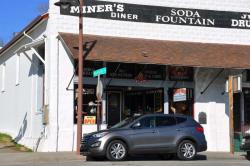 Julian, California. Click image to enlarge |
We sampled the apple pie (of course) at the Julian Pie Company, which has a nice patio out back and serves hot tea (not always to be found in the U.S.). Excellent pie, but the accompanying cheese needed some bite.
After checking out some of Julian’s bookstores, galleries, residential streets and historic buildings, we headed back to San Diego via Highway 78, heading for the coast so that we could drive through Solana Beach, Del Mar, Torrey Pines and La Jolla. An alternative route is to take Highway 79 toward the Sunrise Highway. This is one of California’s most scenic drives, and offers a more direct route to San Diego.
Highway 78, however, is all about twisty canyon roads, and even though our Santa Fe was the “Sport” version, and perfectly capable in this environment, you really wish you were in a two-seat convertible on roads like this. Nonetheless, it’s an agreeable drive behind the wheel of the Santa Fe in these conditions, where again it impresses with its surefootedness and poise. No leaning, understeer or complaints from the 19-inch tires were experienced, even though we proceeded at an enthusiastic pace.
I did notice, however, that the transmission exhibited a certain gear-selection uncertainty and abruptness when ducking and diving through the curves. It was remedied by switching to Sport mode and manually shifting (more fun, too).
We had enough daylight left to stop briefly at the affluent but understated town of Del Mar as planned, and while we’re not horsey people, we know this community of 4,000 residents is notable for its famous Del Mar Racetrack (“where the surf meets the turf”), built in the 1930s by a partnership including Bing Crosby, Jimmy Durante and Oliver Hardy (names from the distant past, I know). Seabiscuit raced there, if that helps.
Del Mar is also home to yet another fabulous beach that you can spend a couple of hours combing if you have the time. Want to stay? L’Auberge Del Mar has my vote.
Just down the road from Del Mar things get even richer. You’ll drive through Torrey Pines State Park, and if you have a chance, stop in at the “The Lodge at Torrey Pines.” I’ve had the good fortune to stay there, and it’s quite a place. Even if you’re not staying, it’s worth a look as its Arts and Crafts (or more specifically, “California Craftsman”) design is most impressive. The whole place appears to have been constructed in the 1900s, although the buildings and furnishings are actually only 11 years old. And I’m told it has a nice little golf course, too…
We didn’t stop at La Jolla with its pristine beaches and perfectly manicured streets. The sun had set; we were done. I have to say that after 400 km, the seats in the Santa Fe Sport were great, even though we didn’t have need of their heating and ventilation. The navigation system was a huge help (it politely asked if it could direct us to a gas station when we were low on fuel) and is simple to operate and read using the new eight-inch touchscreen display. The associated connectivity quickly pairs your phone using pop up messages and understands street addresses and cities in one sentence when using voice commands. It’s one of the most sophisticated and easy-to-use systems I’ve encountered.
We achieved about 10.0 L/100km overall in ActiveECO mode, which is very good for a mid-size SUV.
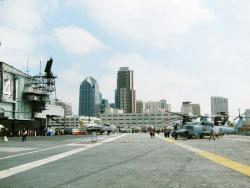 Midway Museum. Click image to enlarge |
This day trip covered a lot of ground and gave us a good sense of the region. The next day in San Diego proper we went to Balboa Park with its 17 museums and galleries, striking landscape and the famous San Diego Zoo. We stopped in at Old Town, which seemed to be the main tourist magnet; too busy and noisy for comfort, but they move people through. The USS Midway Museum was more interesting than I expected, its docents knowledgeable, enthusiastic and professional. You can easily spend a half-day on board.
But having a vehicle makes such a difference when you have limited time, as we did in the San Diego area. The 2013 Hyundai Santa Fe proved easy and comfortable to drive, with fuel consumption bettering many smaller SUVs. It’s an ideal touring vehicle, and the San Diego area is an ideal location for touring.









